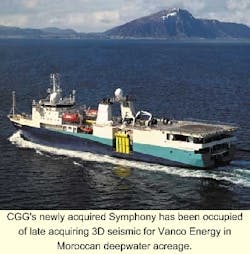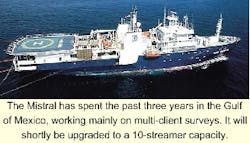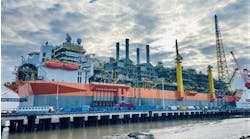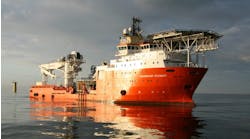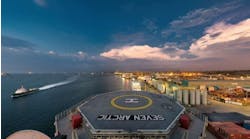After the trauma of the oil price collapse, seismic service contractors are pulling out of a steep slump. Compagnie Generale de Geophysique (CGG) recently ann-ounced full-year revenues for 2000 of $635 million, up 37% from the trough period of 1999. Offshore business volumes have doubled, off-setting problems in the land-based markets, and the mid-term order outlook remains bright.
Four transactions over the past year have also strengthened the company's position. The first two came with Sercel's purchase of Syntron and Mark products, its competitors in the mainstream geophysical equipment market. The third was CGG's buyout of the 40% equity held by Louis Dreyfus Armateurs in CGG Marine, making CGG the 100% shareholder.
Fourthly, CGG took advantage of industry consolidation to buy Aker Geo's two newly built seismic acquisition vessels, Amadeus and Symphony. This brought the company's fleet up from four to six - but more importantly, it owns these two vessels outright, whereas the other four are co-owned or chartered.
According to Gerry Harrison, CGG's Executive Vice President Offshore, Brazil has been a focus for the offshore seismic acquisition industry for the past two years, and will remain so as more foreign operators are admitted. CGG's Harmattan is working there for the fifth year in a row, without let-up. The first two of those years were committed exclusively to Petrobras. Currently, it is engaged in non-exclusive 3D reconnaissance surveys. In the months to come, it will be shooting in all areas of the Campos and Santos Basins.
"We may also allocate another vessel to this sector," Harrison adds. The candidates would be one of three CGG seismic vessels currently on assignment on the other side of the South Atlantic. Of these, the Symphony has been surveying 3,000 sq km offshore Morocco for Vanco Energy across its Safi Haute Mer and Ras Tafelney licenses. The 3D program is focused on the toe-thrust zone in 1,500-2,000 meters water depth, with a secondary interest in deeper inverted structures in 1,800-2,500 meters water depth. The Alize has also been active off Morocco for Enterprise (again 3D).
Offshore Equatorial Guinea, the Amadeus is doing duty for Rocoil and Chevron on newly licensed acreage, while further south, the Fohn is engaged in a shallow water program off Cameroon for Perenco. All these surveys are proprietary, and all the vessels are committed until mid-June. Thereafter, one of them could theoretically sail out to Brazil within 12-14 days, although the Amadeus will certainly head north to complete a major new survey over unlicensed acreage in Norway's Moere Basin.
The survey, which currently has four oil company sponsors, is across an undrilled part of this Mid-Norwegian region. Another CGG vessel could also be diverted to the Faroes, where offshore exploration gets under way this spring.
Under the agreement with Louis Dreyfus Armateurs, a newly created joint venture between CGG and LDA will own the Mistral, which has been dedicated to multi-client surveys in the Gulf of Mexico since 1998, and will likely remain there in future. In readiness for future programs, it will be upgraded later this year to a 10-streamer capacity.
The Mistral spent much of 2000 around the Mississippi Canyon and Green Canyon areas - the "hottest" currently for acquisition and processing, according to Rollin Delzer, CGG's VP for Business Development, Offshore. "We want to stay where our clients are saying is most promising geologically and geophysically - where the lease money is being spent.
Long offsets
"All our work in the Gulf of Mexico has pre-stack time depth migration processing. That requires long offsets and increasing cable lengths towed to over 8,000 meters in order to image the areas beneath the salt. These longer offsets make operations more difficult, but it is necessary to improve on data from areas that have been surveyed before. There also has to be continuous development of what were until recently relatively experimental techniques - pre-stack depth migration is not new, but the concept of applying it to 150 blocks, in terms of computer power, is new."
As for the Far East, CGG has been active in the region as regards seismic data processing, but acquisition opportunities were limited due to the size of its fleet. "But now that we have six vessels, we can re-assess the situation," says Harrison.
Globally, rates even for 3D vessels are still poor, he claims, "although they are better than the low points of 1999-2000. Whether we're in an upward trend remains to be seen from the awards due out this spring." Delzer adds: "Where we are right now is an overhang from last year. We're seeing more and more requests from the Gulf of Mexico for multi-client work. There are also a lot of bids to come in Brazil." The North Sea, however, seems to be showing no signs of improvement.
The cost of the Aker Geo transaction was $118 million for the two vessels, a non-exclusive data library and associated personnel. Of this sum, $25 million was paid in cash, while a large part came from an increase in capital and CGG shares. "Currently, we are pushing through a re-organization of these assets," says Christophe Barnini, CGG's VP for Marketing. "All of their field crews will maintain employment within CGG, plus half of their support staff. On our side, our people are really impressed by the quality of their staff. Most of the Aker Geo people had come from Geco Prakla or PGS."
According to Harrison, "We have three major competitors - Veritas, PGS and Western Geco. The latter has 50% of 3D marine capacity in the world, so they are in a position to dominate - if they want to. But it has made little difference to our position. We're now number three in marine seismic with around 15% of the market in streamer terms, number one in processing, and number one in equipment through Sercel/Syntron."
Harrison does foresee a shift influenced by the move towards solid streamers. The pace of change could be rapid, he claims, after a slow pick-up dictated by the sluggish state of the market. CGG expects to take delivery of its first solid streamer for one of its vessels later this year. In time, he predicts, the technology will be used as a discriminator by the industry when it comes to awarding contracts. "This will entail massive capital spending for some contractors; we have six vessels, but others have a bigger challenge."

